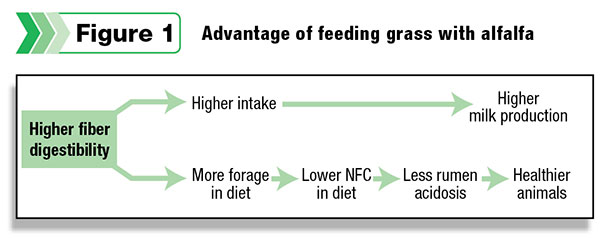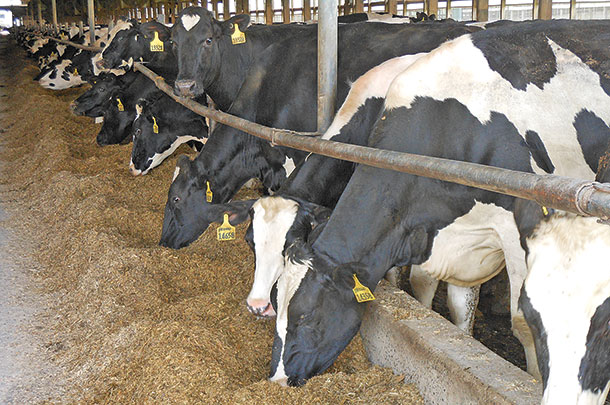We were at a meeting the other day where we overheard producers discussing the high cost of straw. We thought they were using straw for bedding, but many nutritionists are now suggesting adding 2 to 4 pounds of straw to dairy cow rations.
Sounds as if producers might not be producing enough homegrown digestible fiber for their cows.
One of the major challenges dairy producers face is keeping dry matter intake optimized while not pushing cows into metabolic problems. Using homegrown forages is the best way to deal with that issue, but producing consistent forage quality for optimizing animal production can be a major headache.
Use of alfalfa-grass mixtures makes consistency more of a challenge. Alfalfa-grass mixtures can provide a nutritionally better fiber source in rations with multiple benefits. From an animal feeding standpoint, however, there are pros and cons.
Why so little pure alfalfa in the Northeast?
Initially, alfalfa-grass mixtures were favored over pure alfalfa stands in the Northeast due to an abundance of less-than-optimum soils for pure alfalfa, and alfalfa was not as good as it is now. Eventually, we all came to a better understanding of fiber digestibility and the realization that some grass in the diet translated to healthier animals.
Most producers discovered that high-quality alfalfa-grass required more intensive forage management than with pure alfalfa. Over time, most nutritionists are learning how to deal with this mixed forage source. The net result is healthier, higher-producing animals.
Pros and cons
Forage quality is both an agronomic and a nutritional issue, in that we must consider yield as much as quality. More digestible grass forage fiber in mixtures tends to optimize rumen health (Figure 1).
 Grass fiber is typically 10 to 15 percentage units more digestible than alfalfa fiber. Particularly with high-corn silage or high-grain diets, the extra fiber from grass allows effective ration balancing without having to add straw.
Grass fiber is typically 10 to 15 percentage units more digestible than alfalfa fiber. Particularly with high-corn silage or high-grain diets, the extra fiber from grass allows effective ration balancing without having to add straw.
Alfalfa-grass mixtures result in lower non-fiber carbohydrates in the diet and routinely lead to increased butterfat, less acidosis, improved reproduction and reduced laminitis, without altering production.
Alfalfa-grass mixtures are better than pure alfalfa for achieving the desired energy-to-protein ratio for beef cattle on high-forage diets. Mixtures greatly reduce the risk of bloat in pastures.
Forage quality consistency begins in the field
A recent Midwest survey indicated the number one issue facing dairy producers was not forage quality – but forage quality consistency. By far the primary negative issue about feeding alfalfa-grass mixtures is the variability in forage quality.
Consistency of mixtures can only be optimized by harvesting at an optimal time for the mixture in a particular field. Up until recently, there has been no simple method of monitoring species composition of alfalfa-grass fields or upon what has been the best way to do this.
We will soon have a pre-harvest Web tool for estimating alfalfa percentage of mixtures by analyzing photos taken in the field.
Do you know how much alfalfa is in this field (pictured at top of article)? This tool accurately makes that estimation and will be linked to our existing tool for estimating standing fiber (or neutral detergent fiber) content of alfalfa-grass mixtures, used to determine optimum harvest date. (The answer is that the stand is 60 percent alfalfa.)
Working with the Dairy One Forage Laboratory, we also have developed a method for analyzing alfalfa percentage in fresh or ensiled samples using near-infrared spectroscopy (NIRS) technology.
A set of over 500 samples of alfalfa, grass and alfalfa-grass mixtures was assembled, ranging from 0 to 100 percent alfalfa. Samples were forwarded to Dairy One for NIRS analysis and calibration development.
Fresh and fermented samples were combined into one group, yielding a calibration with a regression coefficient of 0.995. Farmers will be able to accurately estimate alfalfa percentages in harvested and stored forage using NIRS.
 Why is it important to know the alfalfa-grass ratio both pre- and post-harvest?
Why is it important to know the alfalfa-grass ratio both pre- and post-harvest?
1. This is required information, along with alfalfa maximum height, to estimate mixed stand neutral detergent fiber.
2. It will help to identify the optimum quality harvest date of mixtures.
3. It will allow ranking of fields for harvest, based on alfalfa percentage.
4. It will help to decide when to start treating a stand like grass, from a fertility standpoint.
5. It can provide information for deciding when to rotate a field.
6. It will help to assess stand deterioration due to alfalfa insect/disease problems (e.g., in New York this includes alfalfa snout beetle damage).
7. Some nutrient record-keeping software requires input of alfalfa percentages.
8. This is required information for some forage quality software, such as MILK2006, alfalfa-grass version.
9. It may help with ration balancing.
10. In quality control, it serves as a check on just how representative your forage sampling is. Highly variable alfalfa percentages over years indicate unrepresentative sampling.
While forage quality analysis primarily provides information to assist in feeding animals, analysis of the alfalfa-grass ratio primarily provides forage management information.
Feeding alfalfa-grass
We conducted a dairy feeding trial using mixtures of tall fescue and alfalfa with 0, 33, 67 and 100 percent alfalfa as the forage source. Replacing one-third of the alfalfa in the diet with tall fescue increased milk production by 5 pounds per day over a pure alfalfa diet.
In a recent Wisconsin feeding trial, one-third of the alfalfa and corn silage in a lactating dairy diet was replaced with meadow fescue.
While this raised the total fiber content of the diet, fiber digestibility increased. The meadow fescue/alfalfa/corn silage diet produced the same amount of 4 percent fat-corrected milk as the control alfalfa/corn silage diet (96 pounds).
New York state traditionally has very similar milk production per milk cow as Wisconsin. Likely, more than 80 percent of New York milk cows are being fed alfalfa-grass mixtures. Wisconsin cows have traditionally been fed 80 percent pure alfalfa, but that is slowly changing.
Conclusions
Including grass with alfalfa provides a source of more digestible fiber that supplies energy to the diet with dropping rumen pH, generally improving herd health. The mixture must be harvested at optimum maturity. Although it takes more management to effectively deal with alfalfa-grass mixtures, they have the potential for higher animal performance. PD
Debbie Cherney is an associate professor of animal science at Cornell University. She can be contacted by email.
PHOTOS: Photos provided by Jerry Cherney.

-
Jerry Cherney
- E.V. Baker Professor of Agriculture
- Cornell University
- Email Jerry Cherney






